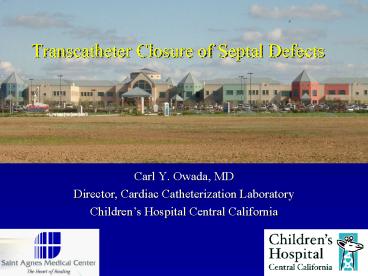Transcatheter Closure of Septal Defects - PowerPoint PPT Presentation
1 / 18
Title:
Transcatheter Closure of Septal Defects
Description:
Hx: 30 y.o. presents with left sided numbness, weakness, ... Symptoms ... a PFO has not been conclusively proven to be causative. PFO and Stroke ... – PowerPoint PPT presentation
Number of Views:412
Avg rating:3.0/5.0
Title: Transcatheter Closure of Septal Defects
1
Transcatheter Closure of Septal Defects
- Carl Y. Owada, MD
- Director, Cardiac Catheterization Laboratory
- Childrens Hospital Central California
2
Case Presentation
- Hx 30 y.o. presents with left sided numbness,
weakness, expressive aphasia, and dizziness.
Symptoms resolved after 1 week. Several months
later patient experienced a second TIA on aspirin
and clopidogrel. Patient has since been
maintained on warfarin. - W/u Carotid ultrasound normal
- EKG normal
- Coag evaluation no identifiable coagulopathy
- Echo suggestion of PFO with spontaneous right
to left shunt during bubble study. - Dx Recurrent cryptogenic stroke and PFO
3
PFO is accused but not convicted
- Prevalence of PFO in the general population is 15
25 - Prevalence of PFO in patients lt 55 yrs with
cryptogenic stroke 50 - PFO size in patients with stroke are larger (2.1
? 1.7mm vs. 0.6 ? 0.8 mm in controls) - Right to left shunt by bubble contrast study is
larger (14 ? 11 bubbles seen in the left atrium
in stroke patients vs. 2 ? 1 bubbles in patients
with PFO but no stroke) - The presence of a PFO has not been conclusively
proven to be causative
4
PFO and StrokeTheorized causal relationship
5
PFO and StrokeTheorized causal relationship
6
Treatment Options
- Medical management
- Aspirin, clopidogrel, warfarin
- Surgical closure
- Percutaneous device closure
- Amplatzer PFO occluder
- CardioSEAL/STARFlex septal occluder
- Helex septal occluder
- Helex septal occluder
- PFO Star Device
- Available under HDE, Remains investigational
7
Indications for device closure
- Humanitarian Device Exemption (HDE) approval
under the Humanitarian Use Device (HUD)
regulations. - PFO occlusion is indicated in patients with
recurrent cryptogenic stroke or TIA due to
presumed paradoxical embolism through a PFO AND
who have failed conventional drug therapy.
8
(No Transcript)
9
Evaluation of cryptogenic stroke
- Ultrasound of carotid and cerebral arteries
- Head CT or MRI
- Screening for hypercoagulability
- Factor V Leiden
- Protein C, S deficiency
- Anticardiolipin antibodies
- Prothrombin mutation
- Antithrombin III
- Cardiac Echocardiogram with contrast study
- TEE
- Transcranial Doppler
10
Indications for closure
- Primary indications
- History of unequivocal and unexplained ischemic
stroke or TIA confirmed clinically and
radiographically AND recurrent event on
conventional anticoagulation - History of stoke or TIA and conventional
anticoagulation is contraindicated
11
Indications for closure
- Secondary indications
- Diving and decompression
- Migraine headache with aura
- Risk of material embolization during orthopedic,
neurovascular or cardiovascular surgery
12
Early outcomes
- Procedural success 95 100
- Complete occlusion
- 50 60 immediate occlusion
- 70 80 at 1 month
- 80 90 at 6 months
- 93 97 at 12 months
- Recurrent stroke or TIA 1.5 2.0 per year (cf.
Medical management 3- 4 per year) - Recurrence rate is higher in patients gt 55 years.
- 60 reduction in migraine headaches
13
Complications
- Procedural 3
- Transient ST elevation
- AV fistulae at the catheter insertion site
- TIA
- Device dislodgement
- Late 1 2
- Device embolization
- Device related thrombus
- Device arm fracture
14
(No Transcript)
15
Back up patient case presentation
- Hx 67 y.o. recently presented with increasing
exercise intolerance and a cardiac murmur - W/u EKG NSR, RVCD, possible RVH
- TEE moderate sized anterior ASD measuring 11
mm with RVE - Diagnostic cath QpQs ratio of 1.91, mean PA
pressure was 22 mmHg - Dx Hemodynamically significant ASD
16
Indications for Intervention
- Atrial Septal Defect
- Symptoms of exercise intolerance, recurrent
respiratory illnesses, difficult to treat RAD,
atrial or ventricular arrhythmia related to
chamber enlargement - Evidence of large left-to-right shunt or minimal
shunt with symptoms - RVH on EKG
- RVE on echocardiogram
17
Treatment Options
- Surgical closure of septal defects
- Relative exclusion criteria include
- Pulmonary vascular disease
- Unstable angina or decompensated CHF
- Recent MI
- LV ejection fraction lt 30
- Transcatheter device closure of the septal
defects - Additional exclusion criteria
- Defect size greater than 38mm
- Defect rim lt 5mm from margin of CS, AV valves,
RUPV - Primum, sinus venosus ASD, or PAPVR
18
History
- 1976 - King and Mills device (23F delivery
system) - 1987 - Rashkind double umbrella (15F)
- 1991 - Clamshell device (11-13F, arm fracture
rate 20) - 1999 - CardioSEAL approved under HDE for
fenestrated Fontans, PFOs, selected VSDs - 2001 - Amplatzer septal occluder is FDA approved
- 2002 - Amplatzer PFO occluder approved under HDE































